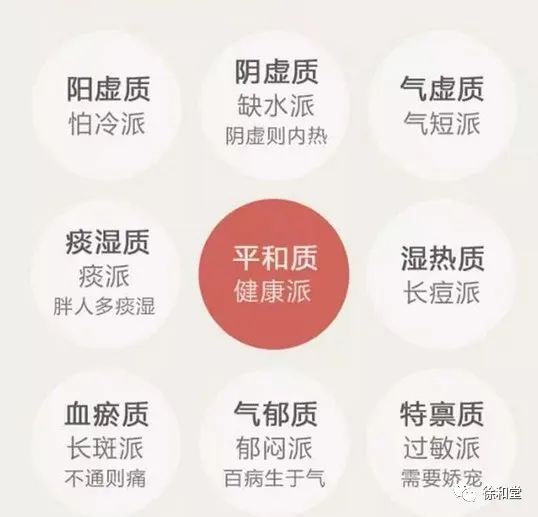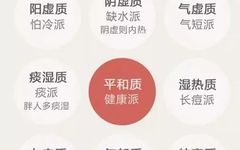In Traditional Chinese Medicine (TCM), there are nine basic body constitution types. Excluding the relatively healthy Pinghe Tizhi (平和体质, Harmonious Constitution), there are eight other types that fall into the so-called sub-healthy states (偏颇体质, Biased Constitutions).

Body constitution is closely related to health and disease, and the methods for health maintenance vary accordingly. In the previous article, we discussed Qi Deficiency Constitution (气虚体质) and Yang Deficiency Constitution (阳虚体质). Today, we will continue to learn about Yin Deficiency Constitution (阴虚体质) and Phlegm-Damp Constitution (痰湿体质)!

Yin Deficiency Constitution
Self-assessment of Yin Deficiency Constitution
Symptoms include soreness and weakness in the lower back and knees, dry mouth and throat, slight dryness in the nose, heat in the palms and soles, tidal fever, insomnia, night sweats, preference for cold drinks, dry stools, short and yellow urine, thin and rapid pulse, and an irritable temperament.

The Yin Deficiency Constitution refers to a state where the body’s essence, blood, and fluids are insufficient, leading to a lack of nourishment and resulting in symptoms of deficiency heat (虚热症状) such as dry mouth and heat in the palms and soles. Therefore, individuals with this constitution can also be referred to as the “Water Deficiency Type”.
Causes of Constitution:
1. Congenital insufficiency, such as advanced maternal age during pregnancy, premature birth, or unexpected events during pregnancy, leading to insufficient essence and qi of the five organs.
2. Irregular diet, favoring yang-boosting foods.
3. Lifestyle not aligned with the seasons, staying up late causing Yin deficiency.
4. External factors such as heat, summer heat, or dryness injuring body fluids.
5. Excessive drinking, smoking, or indulgence leading to Yang hyperactivity and Yin deficiency.
6. Impatience and irritability damaging Yin due to emotional stress.
7. Chronic illness or excessive labor leading to injury of body fluids.
8. External injuries causing blood loss or excessive menstruation, resulting in insufficient body fluids and essence, leading to an imbalance of Yin and Yang.
Tongue Characteristics: Red tongue, little coating, or red tongue with scanty coating.
Shā Characteristics: Red color, little shā, many shā bumps, quick resolution of shā.
How to Regulate:
Dietary therapy: Nourish Yin and clear heat, nourish the liver and kidneys, eat light foods, avoid barbecued and fried foods, and regularly consume Yin Er (Tremella) and Bai He (Lily Bulb).
Acupoint: Recommended Yong Quan (Kidney 1). This acupoint is essential for nourishing Yin; it can be massaged 200 times each night to warm the entire sole of the foot.

Phlegm-Damp Constitution
Self-assessment of Phlegm-Damp Constitution
Symptoms include oily skin, excessive sticky sweat, tendency for hair loss and oily hair, puffy eyes, chest tightness with phlegm, preference for rich foods, and loose muscles.

The Phlegm-Damp Constitution refers to an abnormal metabolism of body fluids, where water and dampness cannot be expelled smoothly, leading to a state characterized by a heavy and turbid sensation throughout the body. This constitution is often referred to as the “Obesity Type”.
Causes of Constitution:
1. Preference for rich and heavy foods, irregular eating habits, leading to accumulation of dampness and phlegm, resulting in obesity and fullness in the abdomen.
2. Emotional imbalance, excessive thinking damaging the spleen, leading to stagnation of qi and accumulation of dampness into phlegm.
3. Living and working environments not aligned with the seasons, prolonged sitting and lack of movement, leading to qi and blood stagnation, or excessive cooling leading to cold-heat imbalance, damaging spleen qi.
4. Liver qi stagnation leading to dysfunction of the spleen’s ability to transport and transform, resulting in accumulation of dampness and phlegm.
Tongue Characteristics: Enlarged tongue body, slippery and greasy coating, often with tooth marks along the edges.
Shā Characteristics: Obese body type, shoulder to waist ratio of 1:1, shā is dark and greasy, producing pig fat shā and milk shā, brown shā.
How to Regulate:
Dietary therapy: Eat small meals frequently, focusing on clearing heat and generating fluids, and eliminating phlegm and dampness. Individuals with Phlegm-Damp Constitution can often consume Luóbo Sī Bǐng (Radish Shredded Pancakes) as a staple food.
Acupoints: Feng Long (Spleen 4) (key point for strengthening the spleen and transforming phlegm), Zhong Wan (Ren 12), etc.

